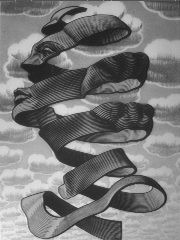
Love to Lucite is based on the life of W. H. Auden, 30's poet and revolutionary. It contains poetry and prose from Auden, C. S. Lewis, Cecil Day-Lewis, and Ecclesiastes. The subtitle reflects its form of composition: a fugue for three actors. We hear themes, harmonies, and counterpoints throughout the text, as the characters struggle with ideological conflict and confusion. The script is written in non- conventional form: the actors' parts read down the page in three columns. If more than one actor has a part on the same horizontal line, those parts are to be read at the same time. Parts of the script form themes that repeat themselves with variations - oddly, often the themes can remain the same while the actors' unspoken subtexts change drastically.
The second part of the work's subtitle, "revolution," connotes the subject matter of the piece. Auden was a revolutionary poet in his day, considered by many to be the spokesperson for revolution in the socialist 30's. His plays from that era reflect the urgent need for social reform that was widely felt, and other poets of his day, like Day-Lewis, launched their revolutionary zeal off Auden's sounding-board. The start of the piece reflects this feeling.
The real core of the work rests in Auden's gradual disenchantment with his socialist ideals as Stalin, Hitler, and the Spanish Civil War tore at his sensibilities. In Modern Canterbury Pilgrims he writes of this turn in his life, which led him, through much soul-searching, to a re- discovery of his Anglican Christian heritage, whose themes and truths reverberate through his later compositions. This paradigm shift forms the center of Love to Lucite.
The three actors of the play's title can be seen in many ways, but most obviously they are competing influences on Wystan. Mark Daniel is a revolutionary, a demagogue, and an orator; the self-proclaimed voice of the people. He is Wystan's mentor, a dynamic figure that showed Wystan the possibility of beneficial change and gave Wystan his purpose in life. But, in a revolutionary uprising taken from the literature of Mexico's modern day Zapatistas, Wystan sees for the first time the destruction, chaos, and death-toll the revolution is responsible for, and starts to question his revolutionary ideals and methods. Beth seems to be a conscience to Wystan; at times the voice of Reality. She is the part of Wystan that is pulling him from Mark Daniel towards a deeper morality. She is also Wystan's wife, a romantic figure based on some shadowy mentions by Auden of an Elizabeth in his poetry. Although Beth at one time supported the revolution and Wystan's calling with her idealism; she has seen the dark side of it, as well.
The play is designed to incorporate yet one more level of counter-point: a slide or film projection screen that, at one point, interrupts the ideologues to present bloody reality. This is what starts to pull Wystan away from Mark Daniel's blindered world-view towards Beth's comparative enlightenment.
Careful work must be done on line readings and timing for a production. It is important that a consistent voice carries through, especially during multiple line-recitals. Generally, when one person begins to speak over another, the other should become quieter while continuing to speak, so that the new voice might be heard clearly. Love to Lucite is based on a shorter work entitled, "Canon of Revolution," which, unfortunately, is no longer on-line. The style of the present piece is well-illustrated in "Canon" (the text of which is found twice in "Love to Lucite," with variations). The center character begins the theme, to be joined by the right-hand character offering a counter-point. Dissonance is created with the addition of one more voice, leading to a tumult and crescendo - and the introduction of the second theme by the center. The right and left characters offer responses to the theme, then we cadence, and the piece is finished. This musical structure is the basis of both Canon of Revolution and Love to Lucite.
| cananian@mit.edu |
|